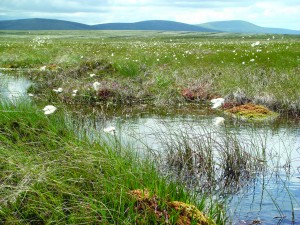 Press Release issued for 8th July 2020
Press Release issued for 8th July 2020
IPCC – Shocking degradation of Irish Peatlands needs Action Plan with Climate focus
The Irish Peatland Conservation Council (IPCC) are undertaking an independent review of the status of Irish peatlands to inform a Peatlands and Climate Change Action Plan 2021-2030 due to be released later this year.
In this first IPCC review of 10 years we are examining the quality of over 1000 peatlands of conservation importance in Ireland held in our sites database and are shocked with the findings. The quality of our peatlands has deteriorated substantially since our last review and the result is that the sites are not as resilient to the impacts of climate change and disrupted weather patterns. “This is a cause of great concern and needs to be urgently tackled” says Paula Farrell, IPCC’s Campaign Officer.
For example, blanket bogs characteristic of the west of Ireland and mountain regions are being fragmented by forest plantations, turf cutting and poorly cited wind farms.
Raised bogs are being physically removed from the landscape through turf cutting for domestic use and for the production of horticultural peat. Many people who use moss peat in their gardens are completely unaware that they are actively contributing to raised bog extinction through their use of this product. “All moss peat bogs should carry a biodiversity health warning” says Paula Farrell.
IPCC carried out extensive research into the threats of all 1182 peatland sites listed within our database and were stunned by the results. Turf cutting has impacted 32.91% and 35.7% have been impacted by drainage (see Note 1). A staggering 53 out of 89 Blanket Bog SAC’s listed in our database have been impacted by turf cutting. Only 8.38% of all our listed sites have undergone any restoration works.
Centuries of human use of peatlands have caused the loss of over 70% of the habitat and are continuing to degrade sites that should be protected for their biodiversity, water regulation and carbon storage and sequestration functions.
Peatlands and climate go hand in hand. Climate has influenced the formation of bogs for thousands of years creating the perfect conditions for peat accumulation in the lake basins or poorly drained soils. Likewise, peatlands can influence current and future climate. Peatlands are a carbon sink with Irish bogs storing carbon annually. This has been going on for 10,000 years with the result that up to 57,402 tonnes of carbon is stored each year by intact bogs (see Note 2). Draining bogs lowers the water table that allowed the carbon to be sequestered in the first place and switches on a decomposition process that releases the stored carbon and other greenhouse gases to the atmosphere. Once the natural carbon cycle is undermined in peatlands, they become a net source of carbon into the atmosphere contributing to climate change.
You would expect that with the high level of awareness of the importance of peatlands in climate regulation and how cheap restoration is that we would be really working to restore the bogs and reap the benefits of the carbon savings in our climate adaptation strategies. But this is not the case. The IPCC Action Plan on Peatlands and Climate Change will be campaigning on this issue. We want, complete designation of sites, monitoring of quality, more funding for restoration and the proper enforcement of planning law across all types of peatland use.
“We really need to work together to restore our peatlands before it is too late. They are important carbon sinks and home to rare and wonderful species”, says IPCC’s Campaign Officer, Paula Farrell.
IPCC are hopeful for the future, but we cannot do this alone. We need your help. You can make a difference and help protect peatlands by donating to our important cause here http://www.ipcc.ie/nature-shop/#!/Peatlands-and-Climate-Change-Action-Plan/p/13414017/category=3094769.
The New Peatlands and Climate Change Action Plan 2021-2030 is made possible through funding from IPCC supporters and friends of the bog.
- Table showing the number of sites listed out of a total of 1182 on the IPCC database that have been impacted or threatened by human activities such as turf cutting, wind farm development, forestry and drainage including sites which are designated for protection.
| Threats | Percentage of sites in database impacted |
| Turf cutting (including turf cutting by hand and machine and moss peat extraction) | 32.91% |
| Wind farm developments | 3.38% |
| Forestry | 21.49% |
| Drainage | 35.7% |
- Renou-Wilson, F. et al., 2011. Strive – Report Series No. 75 – Bogland: Sustainable Management of Peatlands in Ireland, Wexford, Ireland: Environmental Protection Agency.
